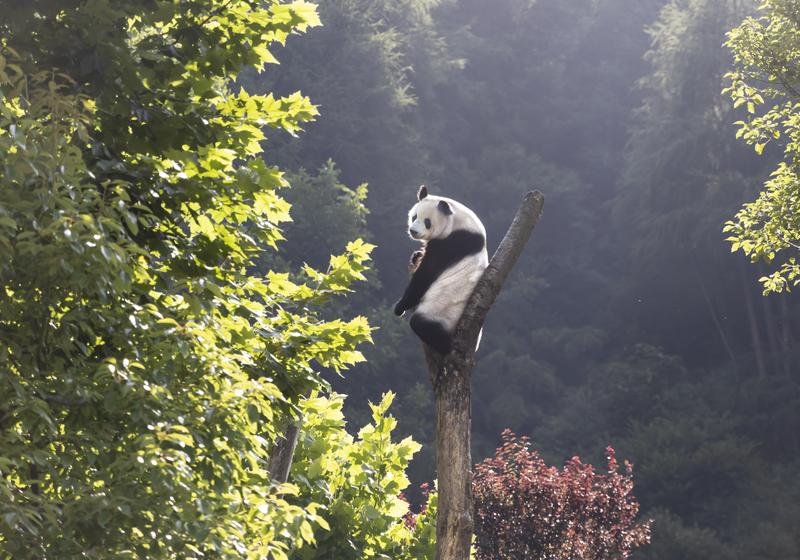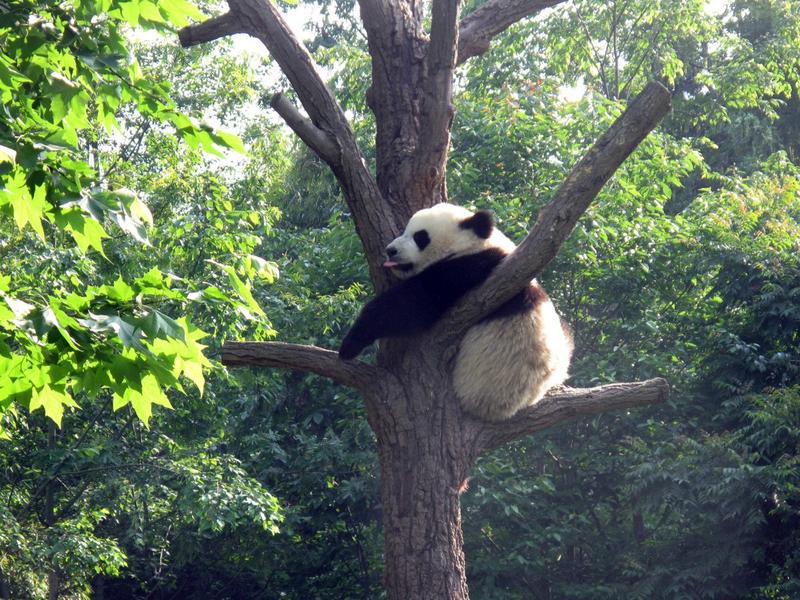Ranger places life on the line patrolling dangerous terrain, but he believes the rewards are worth the risk, Wang Qian reports.
 Sichuan province is home to some of the major panda habitats in China. (CHEN XIANLIN / FOR CHINA DAILY)
Sichuan province is home to some of the major panda habitats in China. (CHEN XIANLIN / FOR CHINA DAILY)
Editor's note: China is home to 56 UNESCO World Heritage sites. To find out how these natural and cultural gems still shine and continue to inspire the nation in this new era of development, China Daily is running a series of reports covering 10 groups of selected sites from across the country. In this installment, we take a close look at picture-perfect Jiuzhaigou and its diverse wildlife, as well as the culinary tradition of Sichuan province.
The day starts early for Shi Xiaogang, a wildlife ranger at the Wolong National Nature Reserve in Southwest China's Sichuan province. Before 6 am, he is ready and geared up, carrying a large backpack weighing about 20 kilograms.
Usually consisting of 10 rangers, Shi's team conducts long-range patrols, lasting up to two weeks, in some of the most extreme environments in the reserve. Every year, they spend more than 200 days on the front line of wildlife conservation.
As head of the reserve's Mujiangping protection station, Shi monitors the population of giant pandas and snow leopards, helps mitigate human-animal conflict and educates local communities. It is a challenging and, often, dangerous job.
Throughout his 30-year career, the senior ranger has frequently put his life on the line to protect Wolong's endangered wildlife.
"In the wild, you must be prepared for tough situations, such as landslides, avalanches or even a vicious wild animal," the 50-year-old ranger says, adding that survival techniques are necessary for work in the wilderness.
Covering about 200,000 hectares, Wolong is home to one of the largest remaining giant panda populations in China. Thanks to rangers like Shi, the number of wild giant pandas in the reserve has increased from 104, according to the fourth national panda survey released in 2015, to 149, says a DNA-based study released last year. In 2016, the International Union for Conservation of Nature announced that the giant panda's status had been changed from "endangered" to "vulnerable" on its Red List of Threatened Species.
As well as "the home of giant pandas", the reserve is widely known as a "bio-gene bank". It features a great number of endemic and threatened species of plants and animals, including other iconic creatures, such as the red panda, snow leopard and clouded leopard among the 121 species of mammals recorded. There are also 392 bird species.
To mark their hard work and contribution to wildlife protection in the reserve, last year, Shi's 20-member squad was recognized with special commendations at an online award ceremony for the IUCN World Commission on Protected Areas' International Ranger Awards.
 A panda rests in a tree at the Chengdu Research Base of Giant Panda Breeding in Southwest China's Sichuan province. (uang Zhiling / china daily)
A panda rests in a tree at the Chengdu Research Base of Giant Panda Breeding in Southwest China's Sichuan province. (uang Zhiling / china daily)
Kathy MacKinnon, head of the commission, speaks highly of the rangers' work, saying that they are "critical to our global conservation efforts, helping to stem biodiversity loss and protect the important ecosystems that serve as natural solutions to climate change and other global challenges".
Shi realizes that through protecting endangered animals, like giant pandas and snow leopards, the rich biodiversity of the environment can also be maintained, which is a win-win situation.
After graduation from Sichuan Forestry School (now Sichuan Agricultural University) in 1992, Shi became a forest guardian at the Wolong National Nature Reserve. He worked on the third and fourth national panda surveys.
Established in 1963, Wolong is the country's earliest panda reserve. It experienced serious human-animal conflict, such as illegal logging and hunting before the 1990s. In 1978, an observation tent, claimed to be the country's first field camp to study wild giant pandas, was built on a steep forested slope in the reserve.
In the early 1980s, the government cooperated with the World Wide Fund for Nature to establish the China Conservation and Research Center for the Giant Panda to save the endangered animal.
In the eyes of Zhang Hemin, the center's founder and former deputy director, the Shi realizes that through protecting endangered animals, like giant pandas and snow leopards, the rich biodiversity of the environment can also be maintained, which is a win-win situation.
After graduation from Sichuan Forestry School (now Sichuan Agricultural University) in 1992, Shi became a forest guardian at the Wolong National Nature Reserve. He worked on the third and fourth national panda surveys.
Established in 1963, Wolong is the country's earliest panda reserve. It experienced serious human-animal conflict, such as illegal logging and hunting before the 1990s. In 1978, an observation tent, claimed to be the country's first field camp to study wild giant pandas, was built on a steep forested slope in the reserve.
In the early 1980s, the government cooperated with the World Wide Fund for Nature to establish the China Conservation and Research Center for the Giant Panda to save the endangered animal.
In the eyes of Zhang Hemin, the center's founder and former deputy director, the center confirms that China views the scientific protection and research of giant pandas from a global perspective.
Researchers from the Institute of Vertebrate Paleontology and Paleoanthropology of the Chinese Academy of Sciences found that the ancestor of the giant panda is the Ailurarctos that lived about 8 million years ago. Treated as a national treasure, giant pandas are one of the flagship species to be protected by the Wolong rangers.
 A research team treks above the clouds searching for snow leopards. (PHOTO PROVIDED TO CHINA DAILY)
A research team treks above the clouds searching for snow leopards. (PHOTO PROVIDED TO CHINA DAILY)
Challenging patrols
Building a "harmonious relationship "between wildlife and the locals has long been a part of the conservation work. Shi tried to educate communities and cooperate with nongovernmental organizations to provide employment opportunities for locals.
As threats from humans declined dramatically, rangers, like Shi, still have to face the merciless wrath of Mother Nature.
"Back then it was really difficult for rangers. With no proper outdoor equipment, like insulated jackets or sleeping bags, every patrol could be a life-threatening adventure," Shi recalls, adding that plastic woven bags were commonly used for warmth and as makeshift tents.
For Shi, the real challenges are natural disasters, which cannot be predicted.
He has a vivid memory about a snowslide in June 2017 during a routine patrol.
"We were about to climb over a 400-meter-long mountain pass, about 5,500 meters in altitude, which was the most dangerous place for rangers with snow depth on the ground reaching up to two meters and the wind blowing heavily," Shi recounts, adding that the pass usually takes patrollers more than two hours.
Through the dense fog, Shi and other 15 rangers could hardly see the person next to them. When a ranger tried to make sure everyone was following the team, he shouted: "Can anyone hear me? Is there anyone left behind? Follow up!"
The voice echoed in the mountain and shortly Shi heard thundering sounds and a mass of snow came tumbling down the mountain.
"Snowslide!" Shi shouted in warning, seeing "snow waves" rolling past him. Quickly throwing himself at rock and grabbing onto it, Shi survived but was injured.
"We learned the lesson — never shout at high altitude," Shi concludes.
Bear in mind
There is a lot of hard work involved protecting wildlife, but there are also some perks to the job.
Shi has a soft spot for giant pandas. Although he has patrolled the reserve for three decades, he has only met the pandas twice.
"In 2004 and 2005, the National Forestry and Grassland Administration asked us to record videos of the wild giant pandas in the reserve. We searched for them for several days in the forest, but didn't spot one," Shi says, adding that he still remembers that the video camera he carried was quite heavy.
When they were about to give up, there was a sound from the bamboo forest behind.
"We turned around and saw a fat panda about six meters away, hiding in the woods. It ran quickly," Shi says, describing the scene like hide-and-seek. It was funny to see a group of people chasing the panda in the wild.
"I could almost touch his tail when getting close. When both parties got exhausted, rangers and the panda sat on the ground, staring at one another. The panda seemed to be saying 'you will never catch me'," Shi says with a smile.
The other time was a meeting with a "cute "panda cub sleeping on a branch, Shi recalls.
To better know and protect the giant pandas, the reserve's authorities launched a large-scale investigation into the number of wild giant pandas and their habitat in 2017.
"Through collection and analysis of DNA, it is estimated that Wolong has about 149 giant pandas living in the wild," Shi says, adding it is a "very good "result for the rangers.
So far, there have been more than 100 field observations and personnel patrols at Wolong, which are now equipped with modern equipment, such as infrared cameras and GPS trackers. Staff members, like Shi, are also working on improving the monitoring system for panda habitats and establishing a DNA database for the species.
In October last year, the Giant Panda National Park was established in Sichuan, Shaanxi and Gansu provinces, connecting giant panda habitats that originally belonged to 73 nature reserves. About 72 percent of the country's wild giant pandas are under the park's protection.
Nationwide, the population of wild giant pandas has increased from 1,114 in the 1980s to 1,864 today.
Contact the writer at wangqian@chinadaily.com.cn


